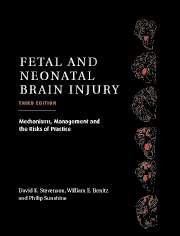Book contents
- Frontmatter
- Contents
- List of contributors
- Foreword
- Preface
- Part I Epidemiology, Pathophysiology, and Pathogenesis of Fetal and Neonatal Brain Injury
- Part II Pregnancy, Labor, and Delivery Complications Causing Brain Injury
- Part III Diagnosis of the Infant with Asphyxia
- Part IV Specific Conditions Associated with Fetal and Neonatal Brain Injury
- 26 Hypoglycemia in the neonate
- 27 Hyperbilirubinemia and kernicterus
- 28 Polycythemia
- 29 Hydrops fetalis
- 30 Acidosis/alkalosis
- 31 Meconium staining and the meconium aspiration syndrome
- 32 Persistent pulmonary hypertension of the newborn
- 33 Pediatric cardiac surgery: relevance to fetal and neonatal brain injury
- Part V Management of the Depressed or Neurologically Dysfunctional Neonate
- Part VI Assessing the Outcome of the Asphyxiated Infant
- Index
- Plate section
29 - Hydrops fetalis
from Part IV - Specific Conditions Associated with Fetal and Neonatal Brain Injury
Published online by Cambridge University Press: 10 November 2010
- Frontmatter
- Contents
- List of contributors
- Foreword
- Preface
- Part I Epidemiology, Pathophysiology, and Pathogenesis of Fetal and Neonatal Brain Injury
- Part II Pregnancy, Labor, and Delivery Complications Causing Brain Injury
- Part III Diagnosis of the Infant with Asphyxia
- Part IV Specific Conditions Associated with Fetal and Neonatal Brain Injury
- 26 Hypoglycemia in the neonate
- 27 Hyperbilirubinemia and kernicterus
- 28 Polycythemia
- 29 Hydrops fetalis
- 30 Acidosis/alkalosis
- 31 Meconium staining and the meconium aspiration syndrome
- 32 Persistent pulmonary hypertension of the newborn
- 33 Pediatric cardiac surgery: relevance to fetal and neonatal brain injury
- Part V Management of the Depressed or Neurologically Dysfunctional Neonate
- Part VI Assessing the Outcome of the Asphyxiated Infant
- Index
- Plate section
Summary
Hydrops fetalis is the term applied to the presence of excess body water in the fetus resulting in skin edema or effusions in the pleural, peritoneal, or pericardial space. Because surveillance during most pregnancies in the USA includes fetal ultrasound, most cases of hydrops will be recognized before birth. An associated abnormality can be diagnosed either antenatally or postnatally in the majority of patients who have hydrops. The prognosis for survival is generally poor. Over 50% of fetuses diagnosed with hydrops die in utero, and of those that survive to delivery, over half will die postnatally despite aggressive support.
Immune hydrops
Immune hydrops is a late manifestation of the destruction of fetal erythrocytes and resultant anemia caused by transplacentally acquired maternal antibodies to fetal red cell antigens. The degree of anemia that causes hydrops is unpredictable, but hydrops most commonly occurs when the hematocrit is less than 20%. Immune hydrops not treated with intrauterine red cell transfusion is associated with a significant risk of fetal death.
Historically, the most common antigen causing an antibody-mediated hemolytic anemia was the Rh D. Anemia as a function of sensitization to the D antigen is infrequent today because of the routine use of passive immunization with Rh immunoglobulin in the management of women who are Rh D-negative. Sensitization to other red cell antigens, including Kell, e and c, also cause fetal hemolytic anemia and immune hydrops.
- Type
- Chapter
- Information
- Fetal and Neonatal Brain InjuryMechanisms, Management and the Risks of Practice, pp. 586 - 592Publisher: Cambridge University PressPrint publication year: 2003



